Russian Icons, 17th–18th c. Non-Destructive, Non-Invasive Diagnostic Methodology for an Integrated Study of Micrographic Triptychs from the Benaki Museum Collection
Abstract
:1. Introduction
Criteria Relating to the Methodology and the Choice of Analysed Spots
2. Materials and Methods
2.1. Visual Examination
2.2. Imaging
2.3. XRF Analysis
3. Results and Discussion
3.1. Metal Frames
3.2. The Panels
3.3. The Canvas
3.4. Design
3.5. Use of Metal Leaves and Striations
3.6. Paint Layers
3.6.1. Pigments
3.6.2. Painting Techniques
The Painting of the Faces and Flesh Parts
The Painting of Garments
4. Evaluation
Author Contributions
Funding
Data Availability Statement
Acknowledgments
Conflicts of Interest
References
- Lelekova, O. Icon Restoration and Research in Russia. In The Art of Holy Russia: Icons from Moscow 1400–1660; Royal Academy of Arts: London, UK, 1998; pp. 87–92. [Google Scholar]
- Sayenkova, E. H Ρωσική Θρησκευτική Τέχνη από τον 15ο έως το 19ο αιώνα (Russian Religious Art from the 15th to the 19th Century); Κρατική Πινακοθήκη Τρετιακόφ (State Tretyakov Gallery): Moscow, Russia; Athens, Greece, 2019. [Google Scholar]
- Pisareva, S.A. Meдныe пигмeнты дpeвнepyccкoй живoпиcи (XI—XVII вв.) (Copper Pigments of Ancient Russian Painting (XI–XVII centuries)); ГocHИИP (GosNIIR): Moscow, Russia, 1998; Available online: http://www.gosniir.ru/library/gosniir-books/copper-pigments.aspx (accessed on 12 January 2020).
- Mother Iuliania (Sokolova). The Iconographer’s Labor. 2015. Available online: http://www.sacredmurals.com/texts/the_iconographers_labor.pdf (accessed on 29 October 2019).
- Grenberg, Y.N. Texнoлoгия и иccлeдoвaниe пpoизвeдeний cтaнкoвoй и нacтeннoй живoпиcию (Technology and Research of Works of Easel and Wall Painting); ГocHИИP (GosNIIR): Moscow, Russia, 2000. [Google Scholar]
- Grenberg, Y.N. Texнoлoгия cтaнкoвoй живoпиcи. Иcтopия и иccлeдoвaниe. (Technology of Easel Painting. History and Research); Изoбpaзитeльнoe иcкyccтвo: Moscow, Russia, 1982. [Google Scholar]
- Nersesyan, L.; Sukhoverkov, S. Бoгoмaтepь Дoнcкaя (Our Lady of the Don); Tpeтъякoвcкaя Гaлepeя (Tretyakov Gallery): Moscow, Russia, 2017. [Google Scholar]
- Nersesyan, L.; Sukhoverko, S. Aидpeй Pyблeв. Cвятaя Tpoицaюю (Andrei Rublev. Holy Trinity); Tpeтъякoвcкaя Гaлepeя (Tretyakov Gallery): Moscow, Russia, 2017. [Google Scholar]
- Herm, C.; Tietze, O.; Belik, Z.; Konopka, D.; Trufanova, O.; Fuhrmann, A.; Weiß, B.; Kaden, J.; Kaliske, M. The Icon Last Supper of the Iconostasis of the Russian Memorial Church in Leipzig: Technological Investigation as Basis for the Modelling and the Numerical Simulation of Historical Works of Art. Stud. Conserv. 2023, 68, 84–101. [Google Scholar] [CrossRef]
- Ghervase, L.; Cortea, I.; Radvan, R.; Ratoiu, L.; Chelmus, A. Complementary investigations of two Lipovan-style icons. Microchem. J. 2018, 138, 509–518. [Google Scholar] [CrossRef]
- Sayenkova, E.; Sverdlova, S. Cимoн Ушaкoв. Дpeвo гocyдapcтвa Mocкoвcкoгo (Simon Ushakov. Tree of the Moscow State); Tpeтъякoвcкaя Гaлepeя (Tretyakov Gallery): Moscow, Russia, 2015. [Google Scholar]
- Sandu, I.; Bracci, S.; Sandu, I.; Lobefaro, M. Integrated analytical study for the authentication of five Russian icons (XVI–XVII centuries). Microsc. Res. Tech. 2009, 72, 755–765. [Google Scholar] [CrossRef] [PubMed]
- Matskovsky, V.; Dolgikh, A.; Voronin, K. Combined dendrochronological and radiocarbon dating of three Russian icons from the 15th–17th century. Dendrochronologia 2016, 39, 60–68. [Google Scholar] [CrossRef]
- Kalliga, A.E. Εικόνες ρωσικής τέχνης, 16ος–18ος αιώνας. Πρόταση μη επεμβατικής μεθοδολογίας για τη μελέτη της τεχνολογίας κατασκευής και εφαρμογή σε μικρογραφικά τρίπτυχα της συλλογής του Μουσείου Μπενάκη (Russian Icons, 16th-18th c. Proposal of a Non-Invasive Methodology for the Study of Technology and Application on Micrographic Triptychs of the Benaki Museum Collection). Master’s Thesis, University of West Attica, Athens, Greece, 2020. [Google Scholar]
- Boycheva, Y.; Drandaki, A. (Eds.) Θρησκευτική τέχνη από τη Ρωσία στην Ελλάδα, 16ος–19ος αιώνας (Religious Art from Russia to Greece, 16th–19th Century); Μουσείο Μπενάκη, ΙΜΣ-ΙΤΕ (Benaki Museum-IMS-FORTH): Athens, Greece, 2017. [Google Scholar]
- Cormack, R. Moscow between East and West. In The Art of Holy Russia: Icons from Moscow 1400–1660; Royal Academy of Arts: London, UK, 1998; pp. 21–26. [Google Scholar]
- Nersesyan, L. O πολιτισμός και η τέχνη την εποχή του ύστερου μεσαίωνα στη Ρωσία (Culture and art during the late Middle Ages in Russia). In H Ρωσική Θρησκευτική Τέχνη από τον 15ο έως τον 19ο αιώνα (Russian Religious Art from the 15th to the 19th Century); Κρατική Πινακοθήκη Τρετιακόφ (State Tretyakov Gallery): Moscow, Russia; Athens, Greece, 2019; pp. 38–59. [Google Scholar]
- Boycheva, Y. Συλλογές ρωσικών εικόνων στην Ελλάδα (Collections of Russian icons in Greece). In Θρησκευτική τέχνη από τη Ρωσία στην Ελλάδα 16ος–19ος αιώνας (Religious Art from Russia to Greece, 16th–19th Century); Μουσείο Μπενάκη, ΙΜΣ-ΙΤΕ (Benaki Museum-IMS-FORTH): Athens, Greece, 2017; pp. 34–41. [Google Scholar]
- Panagopoulou, M. Μελέτη της τεχνολογίας κατασκευής της διακόσμησης οστράκων νεότερης κεραμικής με μη καταστρεπτικές μεθόδους και ηλεκτρονική μικροσκοπία (Study of the Manufacturing Technology Applied for the Decorations on Modern Pottery Sherds Using Non-Destructive Methods and Electron Microscopy). Bachelor’s Thesis, Technological Educational Institute of Athens, Athens, Greece, 2010. [Google Scholar]
- Moon, T.; Schilling, M.; Thirkettle, S. A note on the use of false-color infrared photography in conservation. Stud. Conserv. 1992, 37, 42–52. [Google Scholar] [CrossRef]
- Cartwright, C.; Spaabaek, L.; Svoboda, M. Portrait mummies from Roman Egypt: Ongoing collaborative research on wood identification. Br. Mus. Tech. Res. Bull. 2011, 4, 49–58. [Google Scholar]
- Paraskevopoulou, A.; Rousodimos, G. Το ξύλο των βυζαντινών και μεταβυζαντινών εικόνων της Καστοριάς (The Wood of Byzantine and Post-Byzantine Icons from Kastoria); XAE (Christian Archaecological Society): Athens, Greece, 2002; pp. 84–85. [Google Scholar]
- Hoardley, B.R. Understanding Wood. A Craftsman’s Guide to Wood Technology; The Taunton Press Inc.: Newtown, Russia, 1980. [Google Scholar]
- Catling, D.; Grayson, J. Identification of Vegetable Fibres; Archetype Publications: London, UK, 1998. [Google Scholar]
- Sammons, J.F.D.B. Application of Reflectance Transformation Imaging (RTI) to the study of ancient graffiti from Herculaneum, Italy. J. Archaeol. Sci. Rep. 2018, 17, 184–194. [Google Scholar] [CrossRef]
- Cultural Heritage Imaging, RTI Guide to Highlight Image Capture v2.0. 2013. Available online: https://culturalheritageimaging.org/What_We_Offer/Downloads/Capture/index.html (accessed on 26 December 2022).
- Kantarelou, V.; Axiotis, M.; Karydas, A. New investigations into the statue of Phrasikleia II. A systematic investigation of pigment traces on Phrasikleia statue by means of scanning micro-XRF analyses. Jahrb. Dtsch. Archaol. Inst. 2016, 131, 51–89. [Google Scholar]
- Kantarelou, V.; Karydas, A.; Sokaras, D.; Mahfouz, L.; Qurdab, A.; Al-Saadi, M.; Giannoulaki, M.; Argyropoulos, V. In situ scanning micro-XRF analyses of gilded bronze figurines at the National Museum of Damascus. J. Anal. At. Spectrom. 2015, 30, 1787–1798. [Google Scholar] [CrossRef]
- Paraskevopoulou, A. Διακύμανση των δομικών χαρακτήρων του ξύλου του κυπαρισσιού (Cupressus sempervirens L.) στην Ελλάδα (Fluctuation of the Structural Characters of Cypress Wood (Cupressus sempervirens L.) in Greece). Ph.D. Thesis, National Capodistrian University of Athens, Athens, Greece, 1987. [Google Scholar]
- Dolgikh, A.; Matskovsky, V.; Voronin, K.; Solomina, O. Combined dendrochronological and radiocarbon dating of six Russian icons from the 15th–17th centuries. Dokl. Earth Sci. 2017, 474, 706–708. [Google Scholar] [CrossRef]
- Identification of Textile Materials, 7th ed.; The Textile Institute: Manchester, UK, 1985.
- Goodway, M. Fiber Identification in Practice. J. Am. Inst. Conserv. 1987, 26, 27–44. [Google Scholar] [CrossRef]
- Yakovleva, A. Texникa икoны (The technique of icons). In Иcтopия икoнoпиcи. Иcтoки. Tpaдиции. Coвpeмeннocть. VI–XX вeкa (History of Icon Painting. Origins. Traditions. Modernity VI–XX Century); Tвepcкoй пoлигpaφичecкий кoмбинaт (Tver Printing Plant): Tver, Russia, 2014; pp. 29–40. [Google Scholar]
- Malkov, Y. The Icon Painter in Medieval Russia. In The Art of Holy Russia: Icons from Moscow 1400–1660; Royal Academy of Arts: London, UK, 1998; pp. 79–85. [Google Scholar]
- Sayenkova, E. “Συνεχίζοντας” το Βυζάντιο: Oι Ελληνικές αναφορές στη Ρωσική τέχνη του 16ου αιώνα (“Continuing” Byzantium: The Greek references in Russian art of the 16th century). In H Ρωσική Θρησκευτική Τέχνη από τον 15ο έως τον 19ο αιώνα (Russian Religious Art from the 15th to the 19th Century); Κρατική Πινακοθήκη Τρετιακόφ (State Tretyakov Gallery): Moscow, Russia; Athens, Greece, 2019; pp. 22–37. [Google Scholar]
- Baranov, V.V. Heкoтopыe ocoбeннocти тexники пиcьмa, тexнoлoгии и cтpyктypы пpoизвeдeний Aндpeя Pyблeвa и иx poль в aтpибyции икoн пpaздничнoгo pядa икoнocтaca Блaгoвeщeнcкoгo coбopa Mocкoвcкoгo Kpeмля (Some features of the painting technique, the technology and the structure of Andrey Rubblev’s works and their role in the attribution of the icons of the festive row of the iconostasis of the Annunciation Cathedral of the Moscow Kremlin). Иccлeдoвaния B Koнcepвaции Kyльтypнoгo Hacлeдия (Res. Cult. Herit. Conserv.) 2012, 3, 25–36. Available online: https://www.gosniir.ru/library/conferences/conservation-researches-3.aspx (accessed on 26 November 2022).
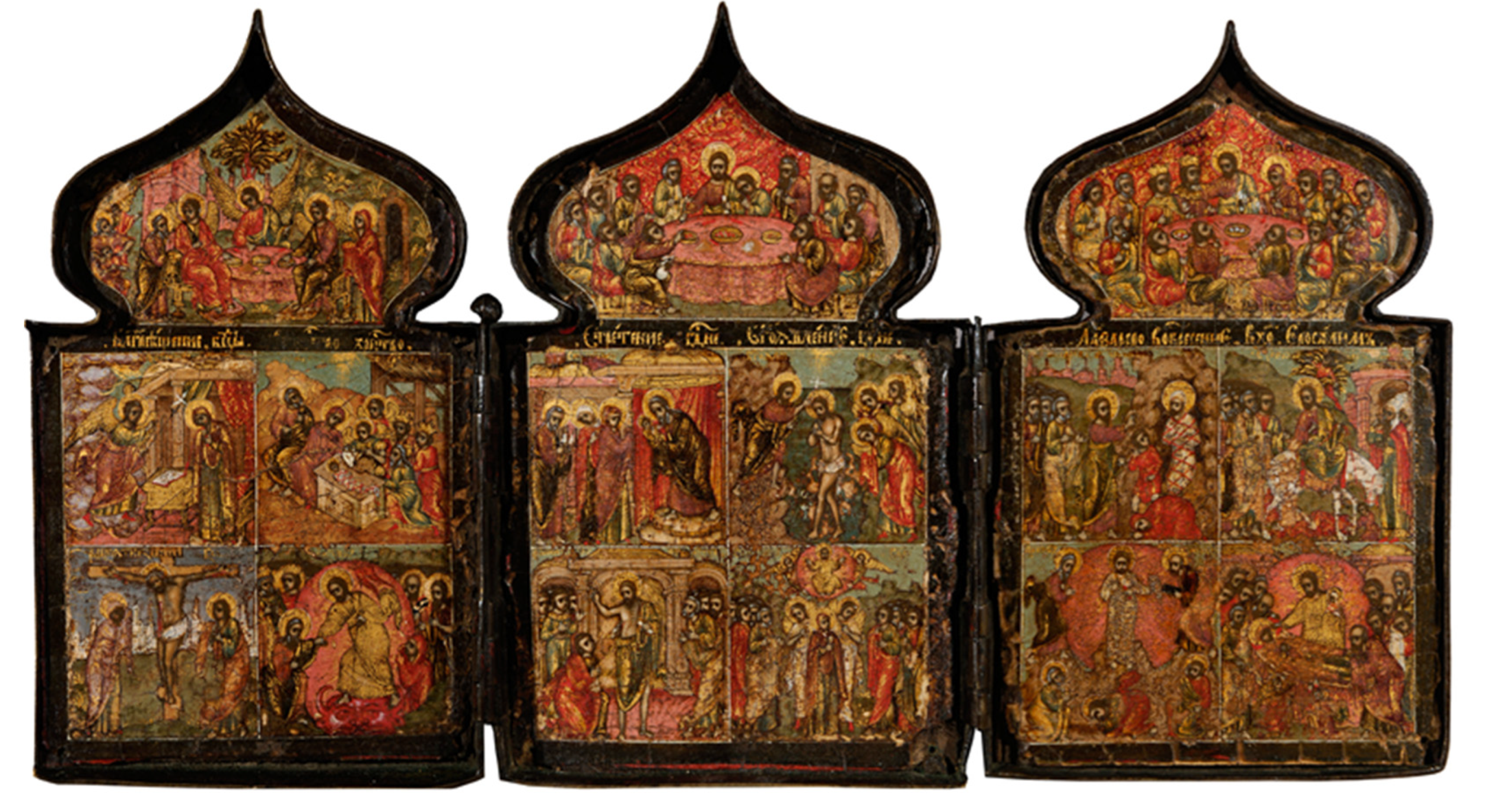
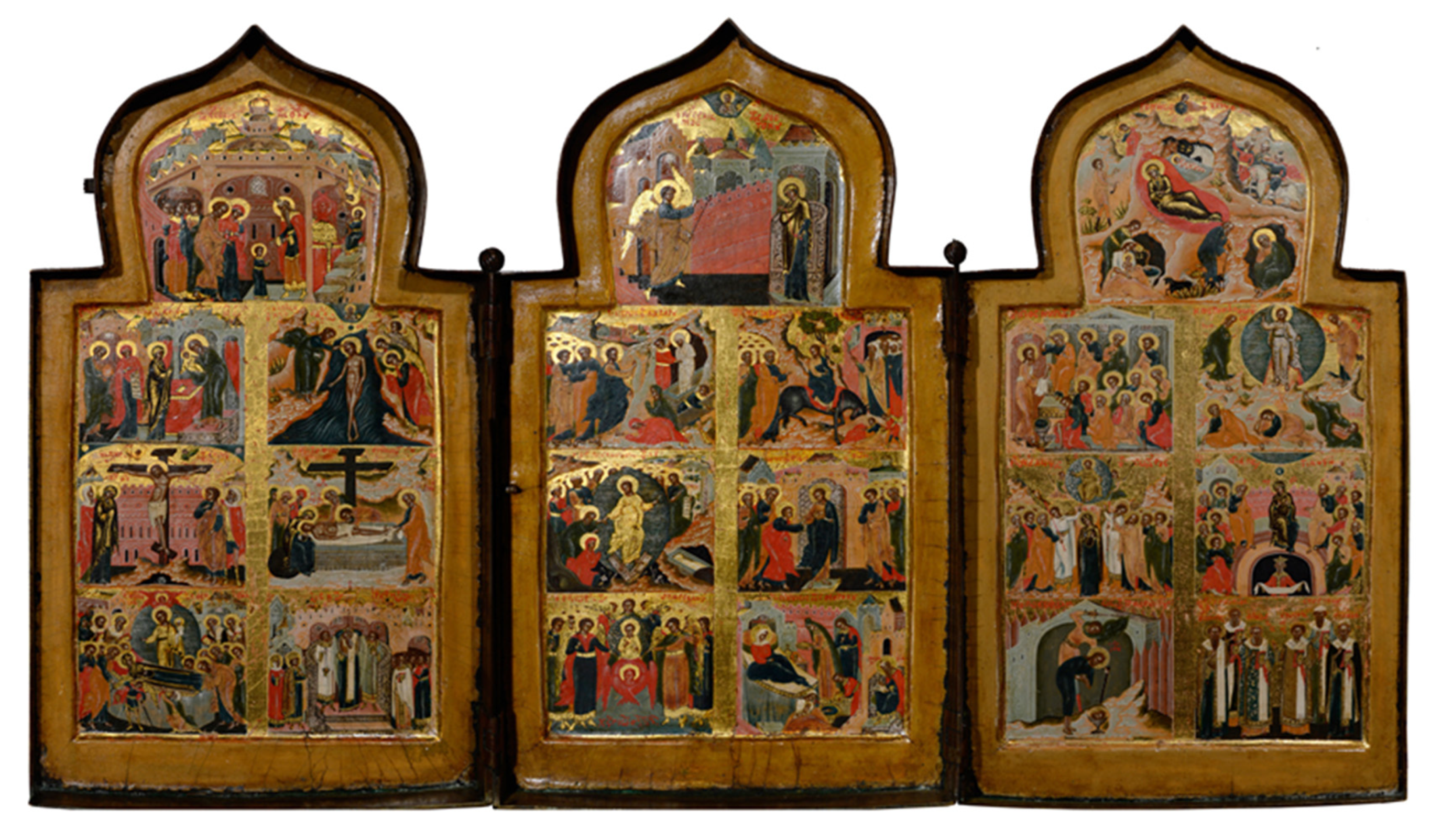
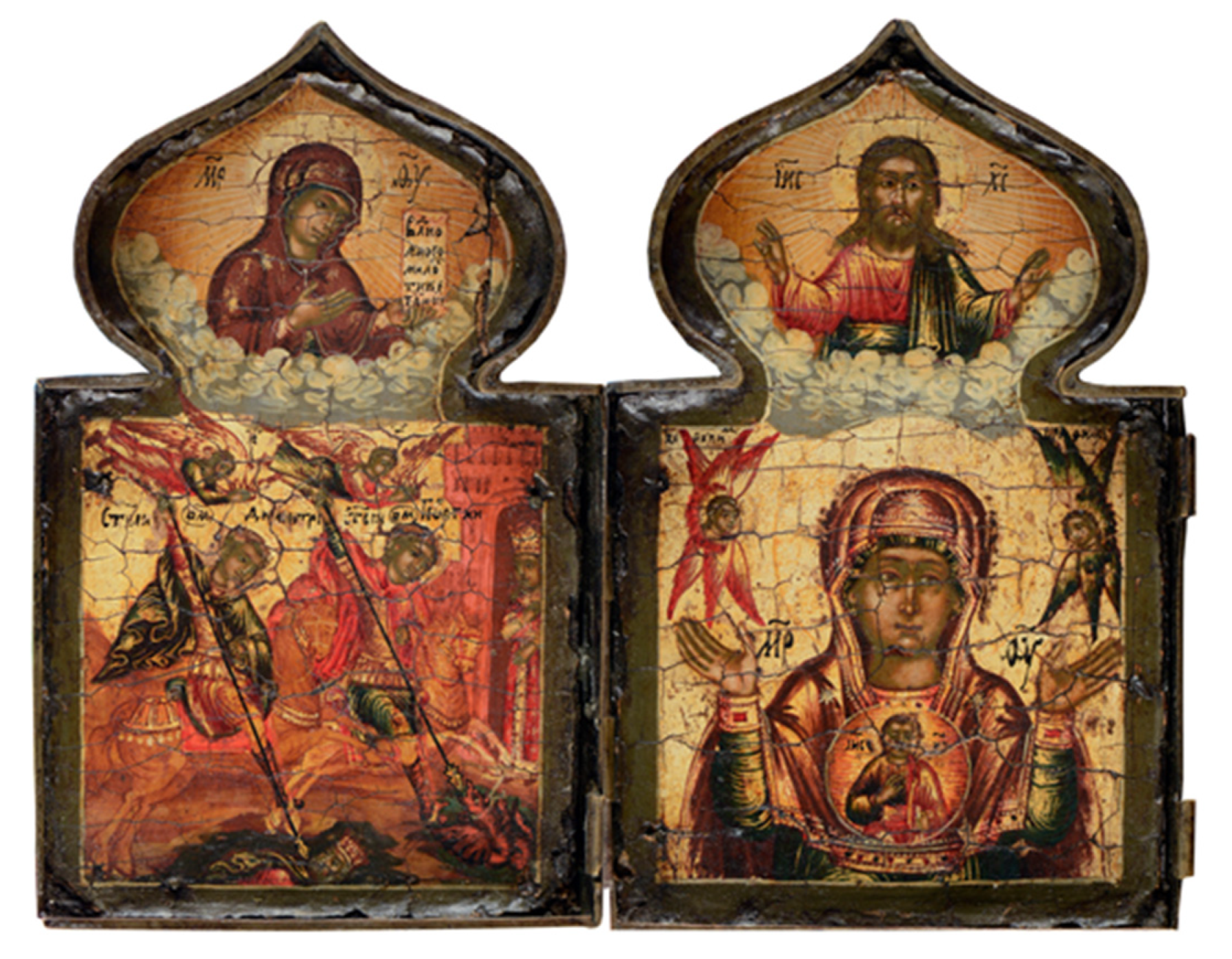
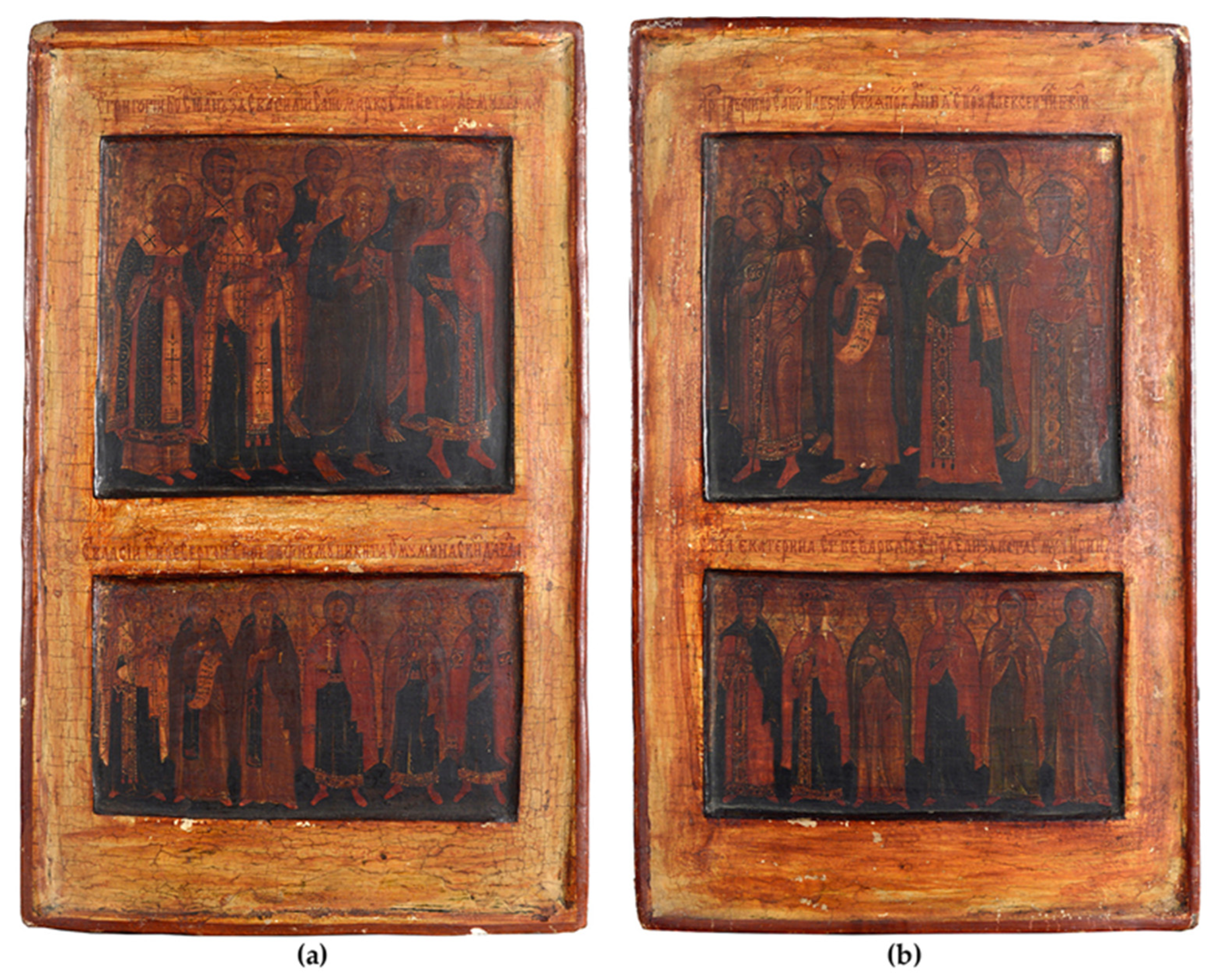
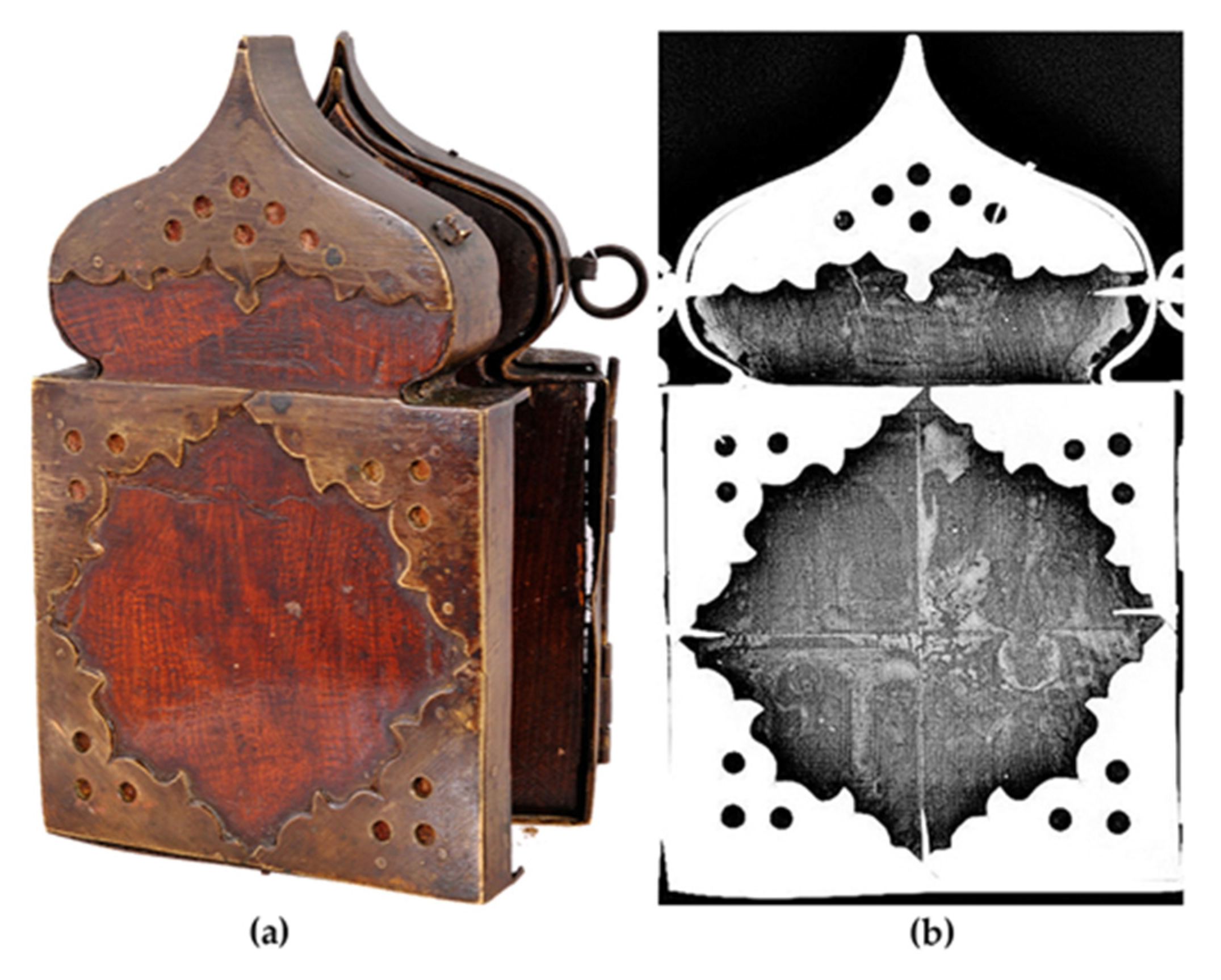
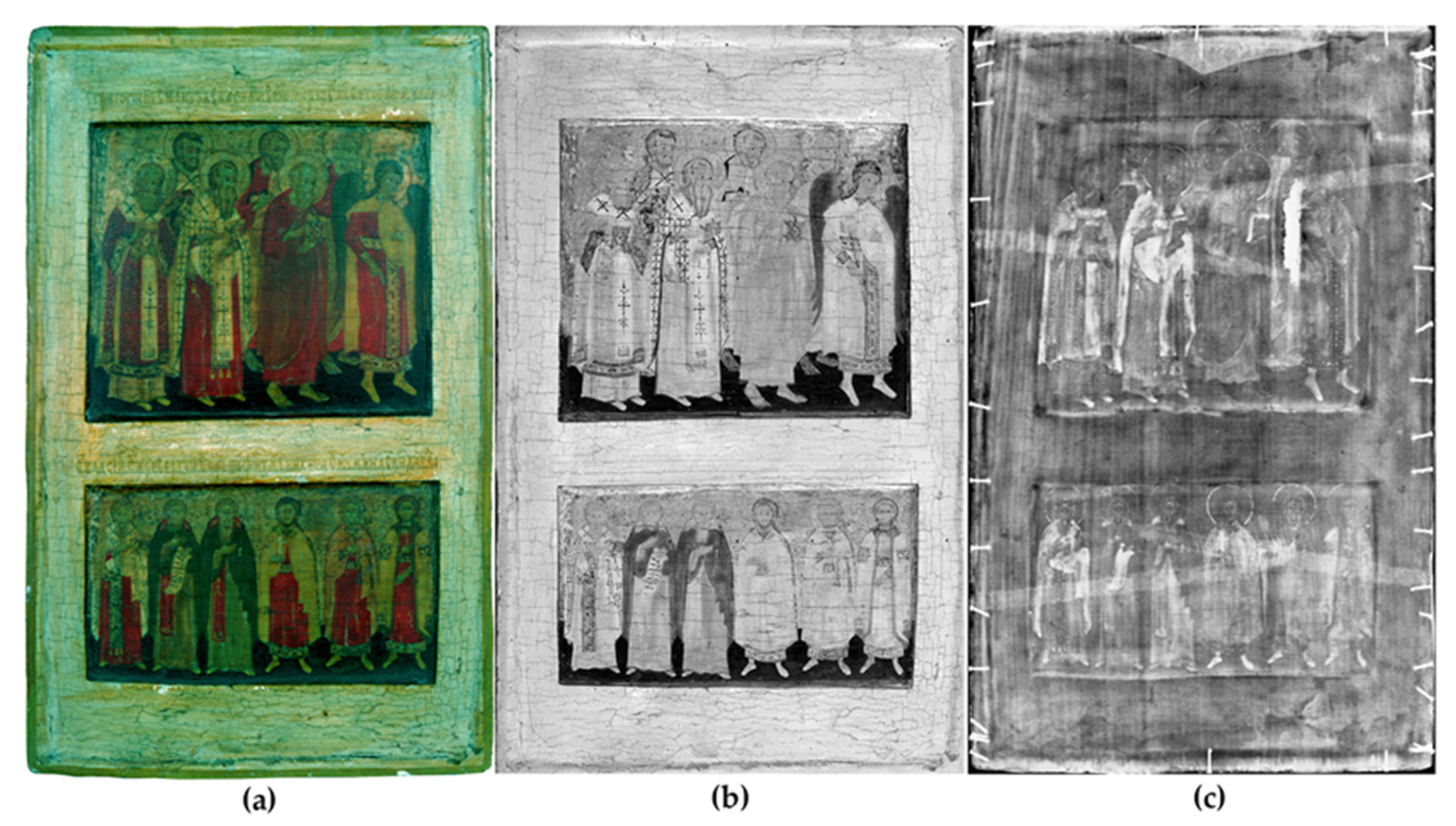
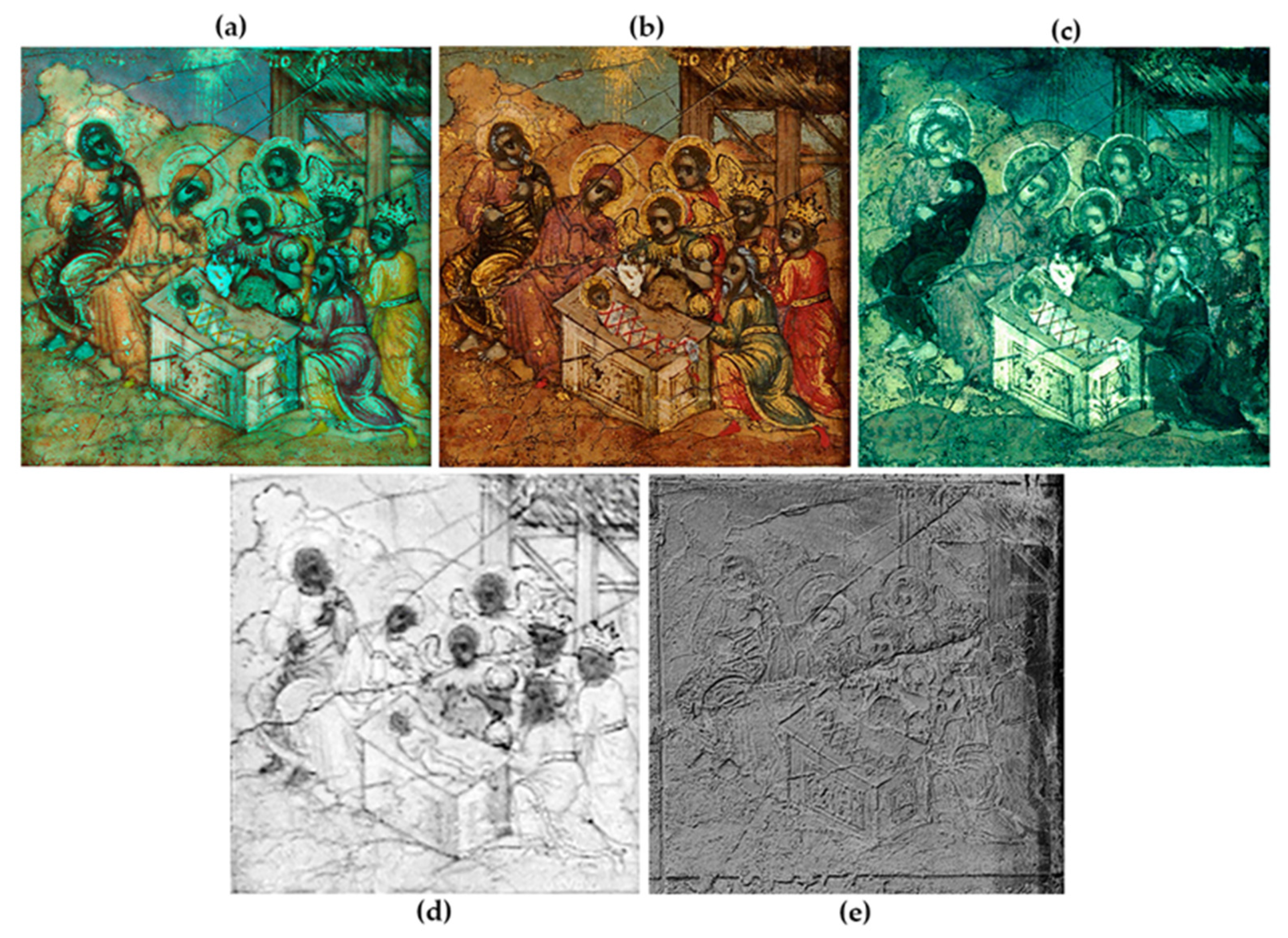
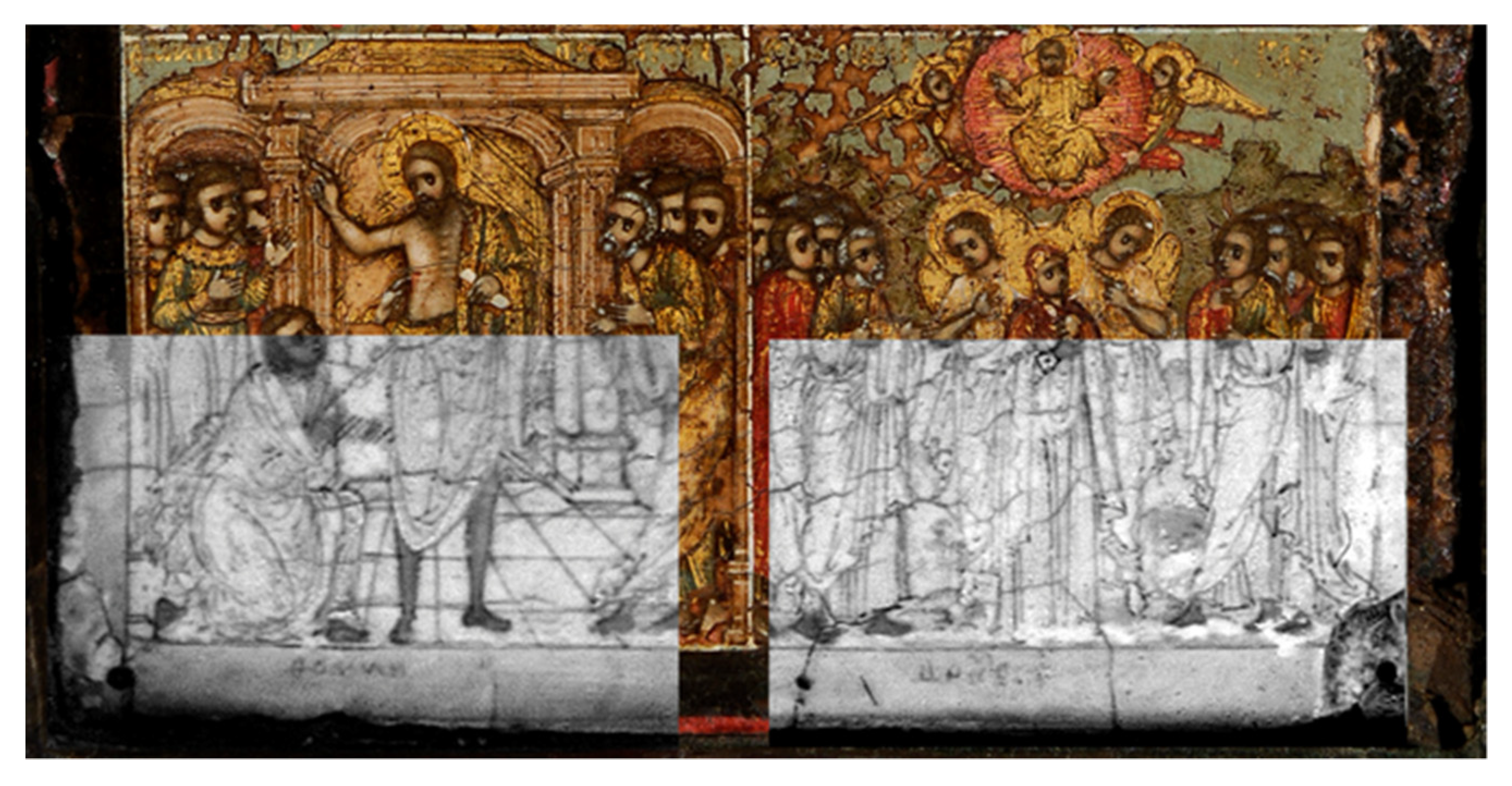

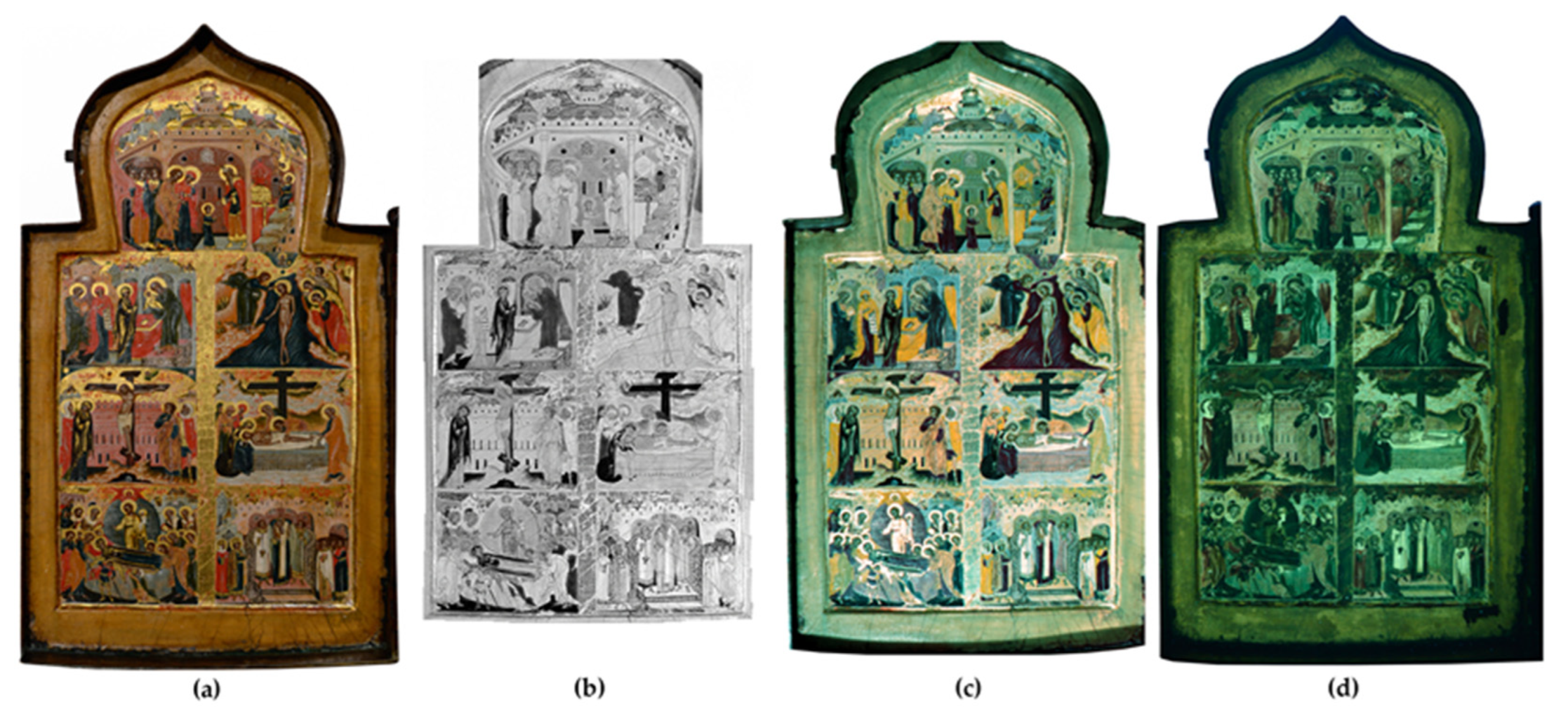
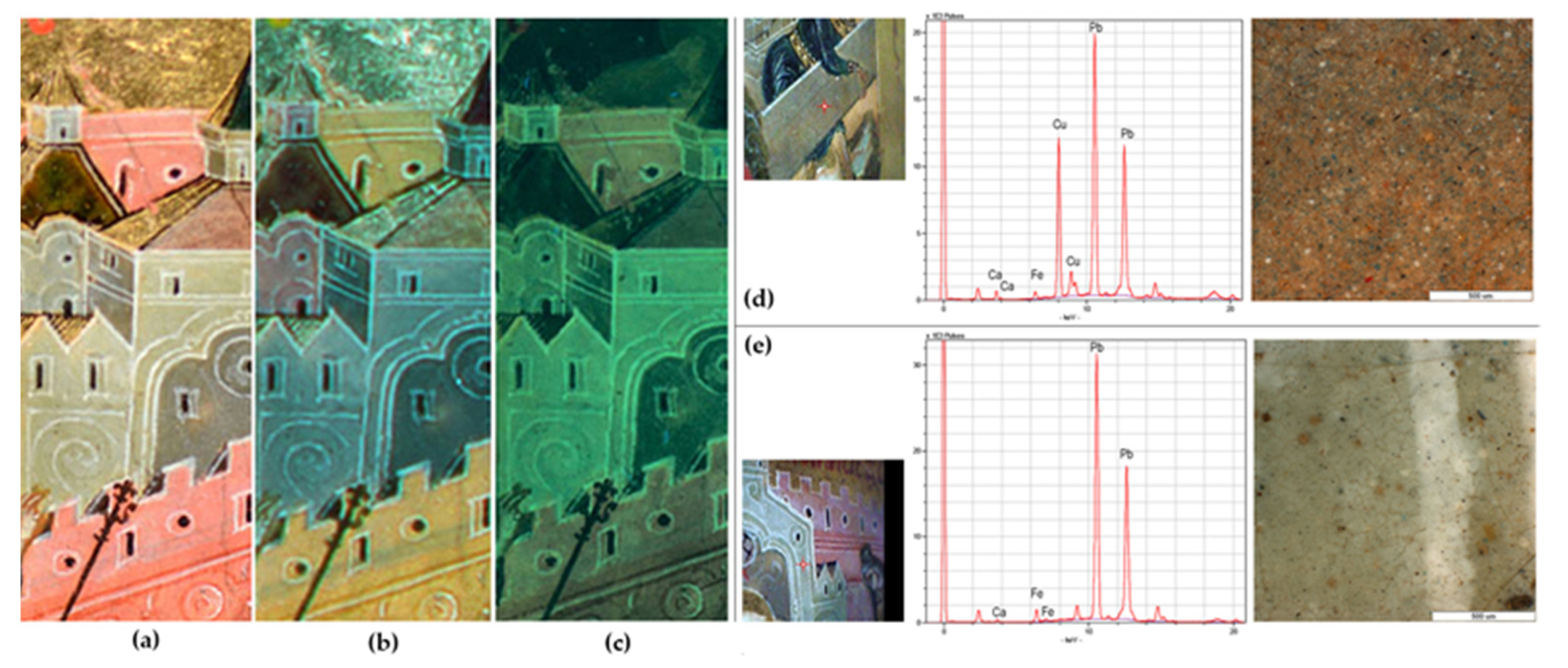
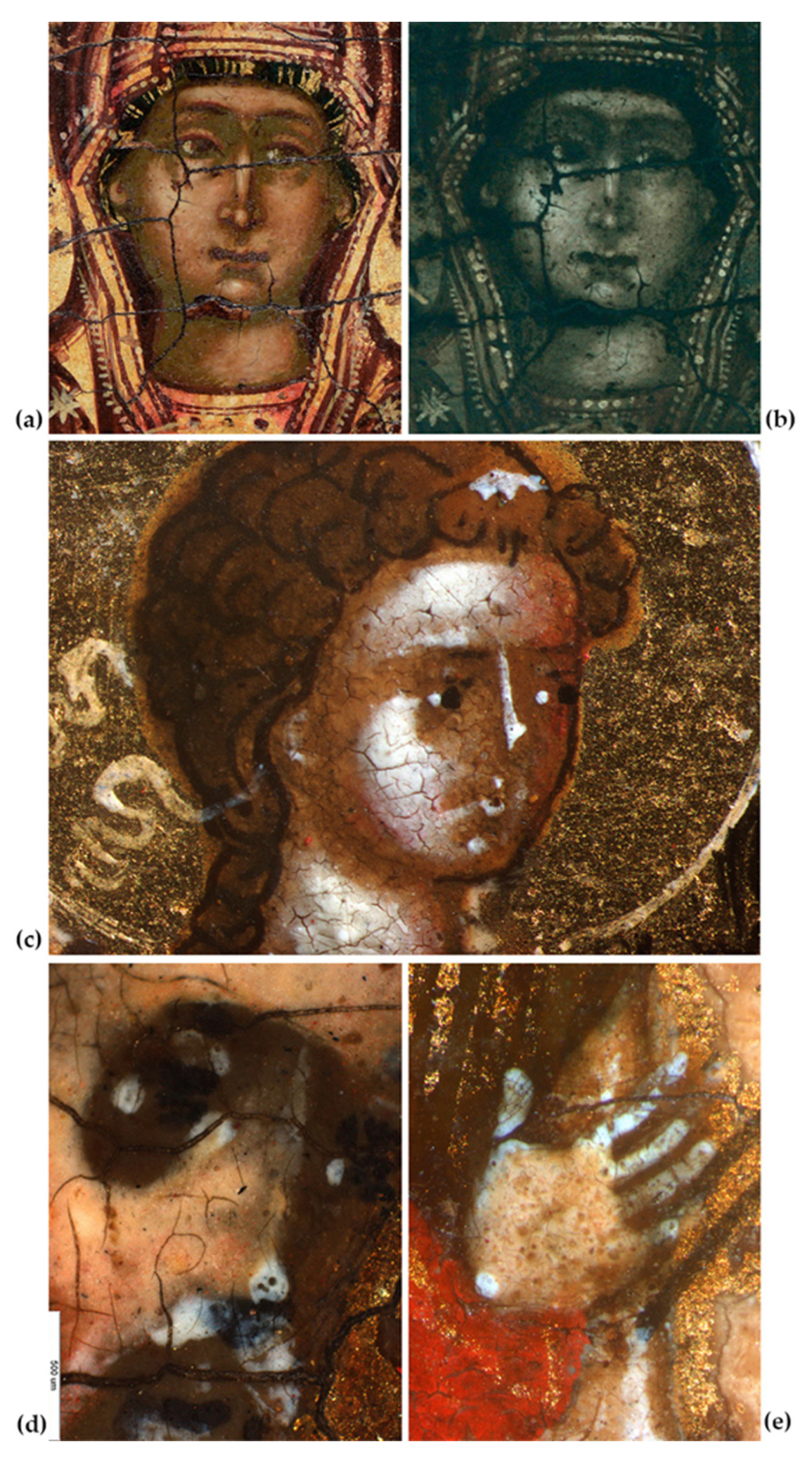
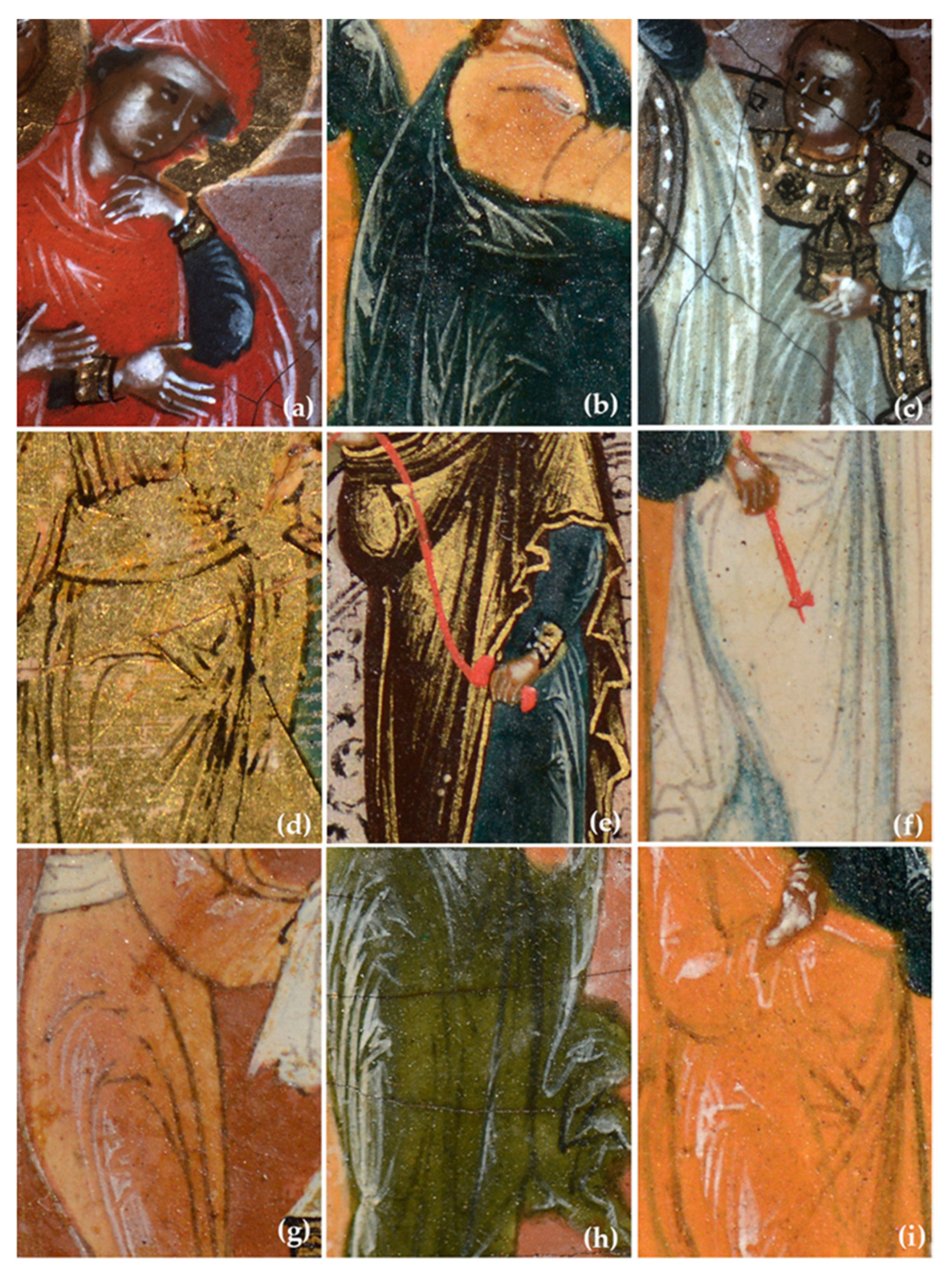

| Pigments | #14126 | #14147 | #14461 | #29534 & #29535 |
|---|---|---|---|---|
| Lead white | ● | ● | ● | ● |
| Carbon black | ● | ● | ● | ● |
| Iron oxides | ● | ● | ● | ● |
| Cinnabar | ● | ● | ● | ● |
| Azurite | ● | ● | ● | |
| Malachite | ● | ● | ● | |
| Copper green (Verdigris) | ● | ● | ● | |
| Green earth | ● | ● | ● | |
| Umber | ● | |||
| Orpiment | ● | |||
| Minium | ○ | ○ | ○ | ○ |
| Ultramarine | ○ | ○ | ||
| Indigo/woad | ○ | ● | ||
| Red lake | ● | ● | ● |
| Colour/Area Description | #14126 | #14147 | #14461 | #29534 & #29535 |
|---|---|---|---|---|
| Browns & salmon pinks Faces & flesh parts | U: red iron oxides, lead white, green earth, carbon black and copper green or blue MT: lead white, iron oxide, cinnabar | U: iron oxides, lead white, green earth MT: lead white, iron oxide S: iron oxide, cinnabar | U: yellow ochre, lead white, carbon black MT: iron oxides, lead white H: lead white | Iron oxides, lead white, cinnabar, green earth U: also includes umber |
| Red garments | U: cinnabar, lead white S: lake | Cinnabar S: lake | U: cinnabar plain or with lead white or minium, carbon black | Cinnabar, lead white and/or minium, iron oxides and/or green earth |
| Orange garments | Iron oxides, cinnabar, lead white, carbon black | Iron oxides, lead white, cinnabar | ||
| Orange (Salmon) garments | Lead white, red lake, iron oxides, azurite | |||
| Pinks | Table cover U: lead white, cinnabar, carbon black S: iron oxide | Building U: lead white, cinnabar, azurite | Building Lead white, cinnabar | |
| Purple maphoria | Red lake | Red lake, iron oxide, carbon black | Red iron oxide, azurite, lake | |
| U: lead white, red iron oxide Sc: red lake | ||||
| Purple garments | U: red iron oxide, lead white, azurite, carbon black | Lead white, cinnabar, umber and/or iron oxides, possibly green earth and lake | ||
| Ochres | Mountain Iron oxides, lead white, carbon black S: lake | Horse Lead white, yellow ochre | ||
| Browns | Garments Azurite or malachite, chervlen or lake, green earth or iron oxides | Hair U: iron oxides, lead white, carbon black | Wings, garments U: umber, possibly red iron oxide, lead white, carbon black, copper blue or green pigment, green earth | |
| Blue garments | Azurite, verdigris or indigo/woad | Ultramarine or indigo/woad, lead white, iron oxides | ||
| Blues | Sky Lead white, carbon black | Building Lead white, azurite, verdigris, cinnabar | ||
| Green garments | Verdigris, lead white | U: green earth, lead white, possibly iron oxides | Malachite, lead white, iron oxides | U: lead white, green earth, orpiment, cinnabar, umber |
| U: verdigris S: iron oxides, lead white or minium | ||||
| Green mountains | Verdigris, lead white, green earth or carbon black | U: lead white, iron oxides, cinnabar S: green earth, carbon black | ||
| Greens | Sky Lead white, azurite | Leaves Malachite, iron oxides | ||
| Background Verdigris, lead white | ||||
| Water Verdigris, green earth | ||||
| Greys | Building U: lead white, iron oxides, carbon black | Garment Lead white, green earth, cinnabar, carbon black | ||
| Hair Lead white, iron oxides, green earth | ||||
| Tomb stone U: lead white, verdigris, carbon black | ||||
| White garments | Lead white | Lead white | Lead white, iron oxides, carbon black | |
| Blacks | Horse U: carbon black, lead white, iron oxides | Background Carbon black, lead white, umber and/or iron oxides | ||
| Ground U: carbon black, iron oxides and/or green earth, lead white |
Disclaimer/Publisher’s Note: The statements, opinions and data contained in all publications are solely those of the individual author(s) and contributor(s) and not of MDPI and/or the editor(s). MDPI and/or the editor(s) disclaim responsibility for any injury to people or property resulting from any ideas, methods, instructions or products referred to in the content. |
© 2023 by the authors. Licensee MDPI, Basel, Switzerland. This article is an open access article distributed under the terms and conditions of the Creative Commons Attribution (CC BY) license (https://creativecommons.org/licenses/by/4.0/).
Share and Cite
Kalliga, A.E.; Alexopoulou, A.G. Russian Icons, 17th–18th c. Non-Destructive, Non-Invasive Diagnostic Methodology for an Integrated Study of Micrographic Triptychs from the Benaki Museum Collection. Heritage 2023, 6, 1325-1343. https://doi.org/10.3390/heritage6020073
Kalliga AE, Alexopoulou AG. Russian Icons, 17th–18th c. Non-Destructive, Non-Invasive Diagnostic Methodology for an Integrated Study of Micrographic Triptychs from the Benaki Museum Collection. Heritage. 2023; 6(2):1325-1343. https://doi.org/10.3390/heritage6020073
Chicago/Turabian StyleKalliga, Alexandra Eleni, and Athina Georgia Alexopoulou. 2023. "Russian Icons, 17th–18th c. Non-Destructive, Non-Invasive Diagnostic Methodology for an Integrated Study of Micrographic Triptychs from the Benaki Museum Collection" Heritage 6, no. 2: 1325-1343. https://doi.org/10.3390/heritage6020073
APA StyleKalliga, A. E., & Alexopoulou, A. G. (2023). Russian Icons, 17th–18th c. Non-Destructive, Non-Invasive Diagnostic Methodology for an Integrated Study of Micrographic Triptychs from the Benaki Museum Collection. Heritage, 6(2), 1325-1343. https://doi.org/10.3390/heritage6020073






